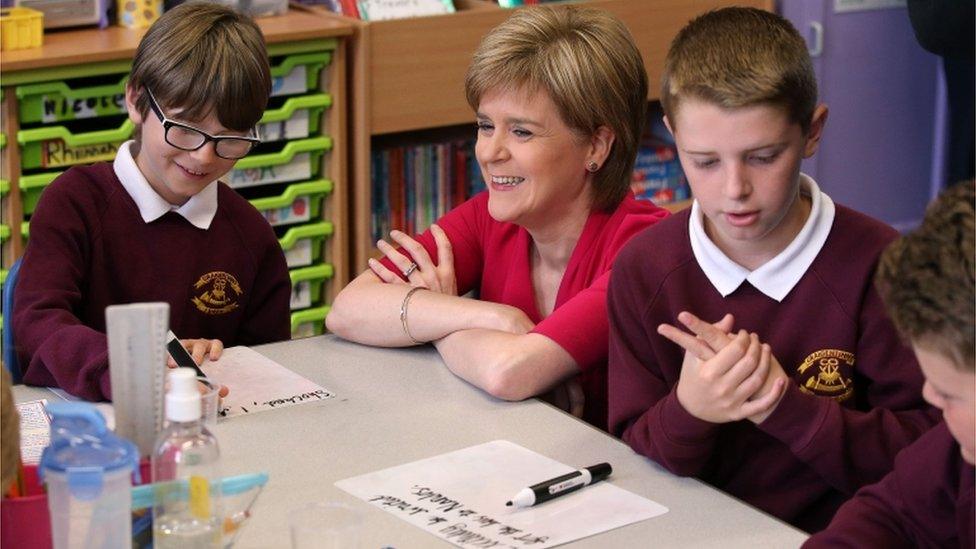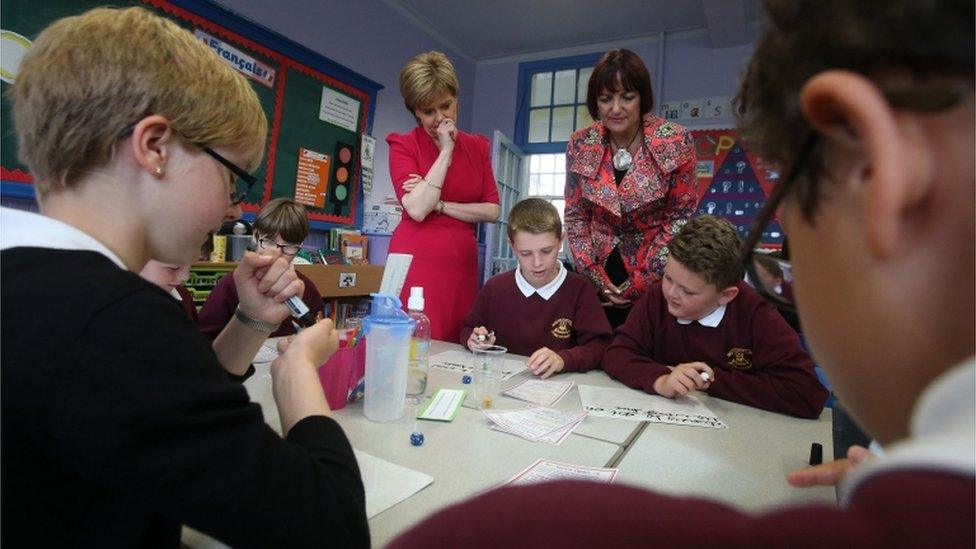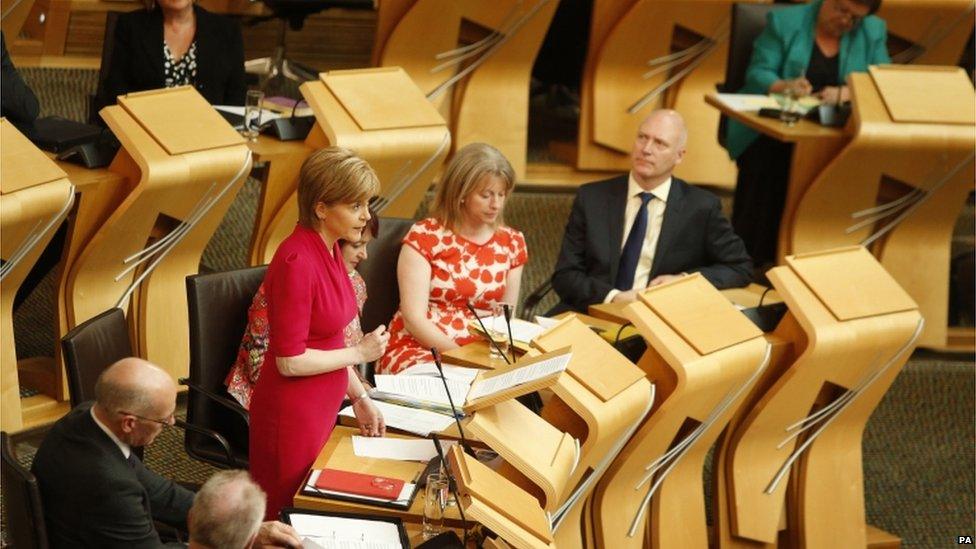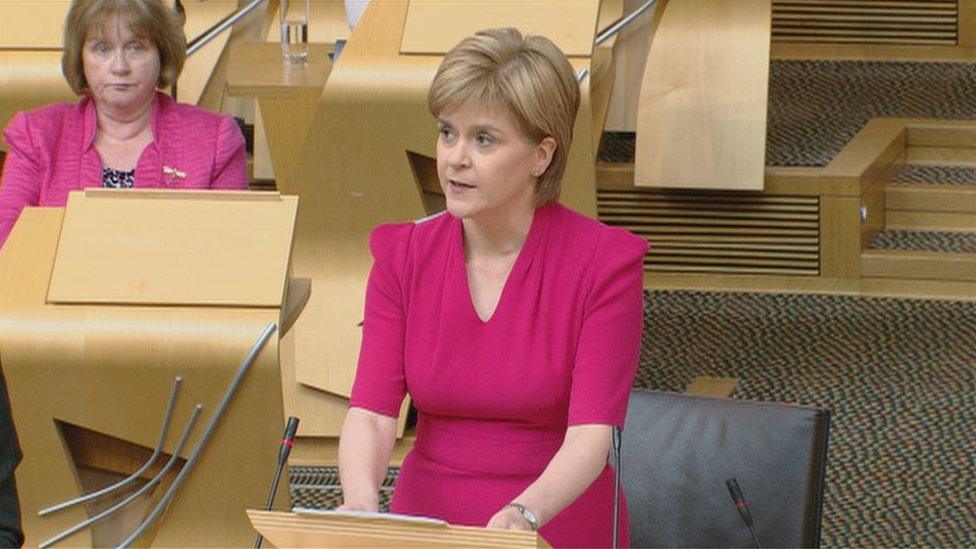How will new school tests work?
- Published

Nicola Sturgeon has introduced a new system of national testing
A new system of national testing is to be introduced in primary schools and early secondary as part of an effort to achieve greater educational equality, First Minister Nicola Sturgeon has announced.

What are the new tests?
The new assessments will focus on literacy and numeracy. Children will sit them in the first year of primary, then in P4 and P7 and in S3 at secondary school.
They will replace the range of assessments which have been used by different councils across Scotland since the old system of national testing was abolished in 2003.
Over time they will also replace the testing of a cross-section of students used to generate the national surveys of literacy and numeracy.
The new assessments will be introduced in 2016 at the schools taking part in the Scottish government's Attainment Challenge - a £100m scheme targeted at local authorities and schools which may face higher than average levels of relative deprivation.
They will be introduced at other schools in 2017. More details on their exact format are expected later.

Will they be controversial?

Much of the devil will be in the detail. If they simply replace the existing assessments - and are not radically different in format - their introduction may be smooth.
However unions and others have warned of a number of risks - adding to the workload on teachers and children, creating unofficial league tables of school performance and undermining or reversing the changes brought in to schools in recent years through Curriculum for Excellence.
The government has been trying to reassure critics and the largest teachers' union the EIS believes the government has been listening, although it still has reservations.

Is this the return of national testing?
Nicola Sturgeon outlines plans for new pupil assessments aimed at improving attainment in Scotland's schools
In a literal sense, of course it is.
The testing will be consistent across Scotland - therefore it is national testing.
However, the Scottish government is not using the phrase national testing for a reason.
It argues the new testing will be very different in practice to the national testing which was scrapped in 2003.
They say it will not be "high-stakes testing" - the driving force is to obtain coherent data from across Scotland to try to work out the best ways of improving attainment in schools and closing the gap between how well children from relatively well-off and deprived communities perform.

Will testing improve attainment?
The government is not pretending that the testing itself will improve attainment.
Their argument is that the data from the tests will give a better indication of how well particular schemes to raise attainment are working.
Obviously those which are succeeding may be copied by other schools or councils if they are considered appropriate.

Might the tests undermine Curriculum for Excellence?

One of the mantras in recent years has been about "more teaching and less testing".
Curriculum for Excellence has seen a general shift in emphasis away from formal testing and assessment.
The government says the new tests will fit into the current system and do not represent a retreat from the changes.
However some teachers fear the new tests could, inevitably, lead to teachers "teaching to tests" simply to try to ensure a school's performance seems as impressive as possible statistically.
Another change in recent years has seen more emphasis placed on trying to help youngsters develop a so-called "deeper understanding" of subjects - applying their knowledge to unfamiliar challenges - rather than simply an ability to answer test questions which may be predictable.
One risk could be that more formalised assessment undermines this.

Will league tables be produced?
The government won't be producing them and has been clear that it won't be judging the performance of a school on test results in isolation.
It is widely accepted within Scottish education that there is far more to judging a school's performance than exam or test results alone.
The argument is that a school in a prosperous area with relatively good results may be coasting while one lower down the table in a disadvantaged area may actually be performing well.
This all leads to the need for what some would describe as an "intelligent reading" of data, which takes a range of explanatory factors into account rather than just numbers alone.
The government is now consulting over exactly what information to publish. Inevitably, one possibility is that data for individual schools would be publicly available.
This may result in journalists, or others, producing unofficial league tables - this already happens for secondary schools.
A challenge for opponents of league tables is to persuade parents not to take the tables seriously or use them as a measure of success.
But it seems almost inevitable that some parents might try to get their children into schools with more impressive performance figures.
- Published1 September 2015

- Published1 September 2015